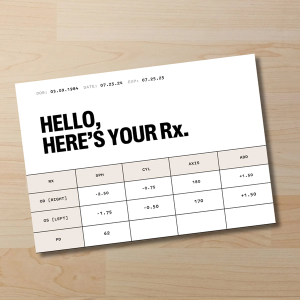I Just Got An Eyeglass Prescription—What Do These Numbers Mean?
Author: Alexander Martin, OD FAAO
You just finished a vision test or eye exam, and now you’re looking at a slip of paper filled with numbers, plus signs, minus signs, and abbreviations. If you’re wondering, “What does any of this even mean?”—you’re not alone. Let’s break it down in simple terms so you actually understand what’s written there.
LEARN MORE
The Basics of Your Prescription
An eyeglass prescription is basically a set of instructions. It tells the optician exactly how to make lenses that will help you see clearly. Every number and letter has a specific meaning—and once you know what to look for, it’s not as confusing as it seems.
SAMPLE RX
What Does This Eyeglass Prescription Mean?
This sample Rx shows mild nearsightedness (myopia) in both eyes, with a small degree of astigmatism. The “Add” value indicates the wearer also needs help seeing things up close—common for people over 40 developing presbyopia. It’s a clear, personalized roadmap to sharper vision.

Key Terms You’ll See on Your Prescription
OD and OS
These letters come from Latin terms that eye doctors still use today:
- OD stands for “oculus dexter,” which means your right eye.
- OS stands for “oculus sinister,” which means your left eye.
(One easy way to remember: OD = “right” and OS = “left.”)
Sometimes you might also see OU, which means both eyes together.
Doctors label each eye separately because it’s very common for your right and left eyes to need different prescriptions.
Sphere (SPH)
This number shows if you are nearsighted (myopia) or farsighted (hyperopia):
- A minus sign (-) means you are nearsighted (you see better up close, but far away objects are blurry).
- A plus sign (+) means you are farsighted (you see better far away, but close-up objects are blurry).
The higher the number (positive or negative), the stronger the prescription.
- SPH -2.50 means you’re mildly nearsighted and need help seeing things far away (myopia).
- SPH +1.75 would mean you’re farsighted and need help seeing things up close (hyperopia).
Cylinder (CYL)
This number shows if you have astigmatism, which is when your eye isn’t perfectly round (more like a football shape instead of a basketball).
Astigmatism causes blurry or distorted vision at all distances.
If there’s no number here, it usually means you don’t have astigmatism or it’s too minor to need correction.
- CYL -0.75 means you have a mild amount of astigmatism that needs to be corrected.
Axis
The axis tells the glasses maker where exactly the astigmatism is on your eye, kind of like giving directions on a map.
It’s a number between 1 and 180 degrees.
- Axis 180° means the astigmatism correction is placed horizontally across your eye.
Add
The Add number gives you extra help for reading and close-up work. It’s usually added for people who are developing presbyopia—the natural aging of the eyes that makes it harder to see things up close.
Presbyopia typically starts around age 40, even if you’ve never worn glasses before.
- Add +2.00 means you’ll get extra magnification in the lower part of your lenses for reading.
You’ll often see Add values when you’re prescribed bifocals, progressive lenses, or reading glasses.
Pupillary Distance (PD)
PD stands for Pupillary Distance.
This measures the distance (in millimeters) between the center of your right pupil and the center of your left pupil.
It is important because it tells the glasses maker exactly where to position the lenses so you’re looking through the right spot. If the PD is wrong, your glasses might feel “off” even if the prescription is perfect.
- A typical adult PD is between 54mm and 74mm.
You might see just one number (like 63mm) or two numbers (like 31mm / 32mm), which separately measure each eye.
In simple terms:
PD makes sure your lenses are lined up properly with your eyes so you see clearly and comfortably.
Optical Center Height (OCH)
OCH (sometimes called Ocular Center Height) measures how high your pupil sits from the bottom of your eyeglass frame when the glasses are on your face.
This helps make sure the optical center of the lens (the part made to be clearest) lines up exactly with your eyes when you’re wearing your glasses.
Example:
- Your OCH might be 18mm or 24mm depending on how big your frames are and how they fit your face.
OCH helps make sure you’re looking through the sharpest, clearest part of your lenses without tilting your head or feeling uncomfortable.
Quick difference between PD and OCH:
- PD measures side-to-side (horizontal distance between pupils).
- OCH measures up-and-down (vertical height of your pupil from the bottom of the lens).
Both are crucial for making sure your lenses work the way they’re supposed to!
Quick Example to Tie It All Together
If your prescription says:
- OD -2.00 -0.50 x 180
- OS -1.75 -0.25 x 170
Here’s what that means:
- You’re nearsighted (myopia) in both eyes (the minus signs).
- You have a small amount of astigmatism in both eyes.
- The astigmatism correction is placed at 180° in your right eye and 170° in your left eye.
Glasses made with this prescription will correct all of that so you can see clearly both near and far.
Understanding your eyeglass prescription helps you feel more confident about your vision care. It’s not just a bunch of random numbers—it’s a customized plan to help your eyes focus light properly, so you can see the world clearly again.
Eyebot’s 90-second vision test makes it fast and easy to get an updated prescription, and every result is reviewed by a licensed doctor to make sure it’s accurate.
If you have questions about your eye health, or it’s been a while since a full eye exam, remember to book a comprehensive eye exam with an optometrist. Both the American Optometric Association (AOA) and the New England College of Optometry (NECO) recommend regular exams to help protect your vision over time.
